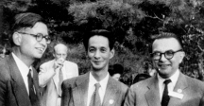Speaker
Description
The existence of powerful Active Galactic Nuclei (AGN) has now been established well within the first Gyr of the Universe, through the observations of tens of optically or near-infrared selected Quasi-Stellar Objects (QSOs) up to the currently highest redshift of z~8. Theoretical work has been developed showing how super-massive (M∼10^9 M_sun) black holes can exist at even earlier epochs, depending on a unknown but necessarily quick assembly and growth of a suitable “seed”. Some of these sources should be bright at radio wavelengths, and detectable well within the Epoch of Reionisation (EoR). These detections will be paramount to the understanding of the earliest stages of galaxy evolution but even more - they will allow the direct study of neutral hydrogen in the Epoch of Reionization, through the Square Kilometer Array project (SKA) observations of the HI 21cm forest against such background radio sources. However, recent radio surveys have shown that, even if very high redshift radio AGN may have been already detected, their identification has proven all but impossible. Attempts to "break this wall" are on-going, but at a frustratingly slow pace. In order to focus the development of future SKA and SKA-pathfinder surveys we have initiated a systematic exploitation of state-of-the-art galaxy formation and evolution models in order to understand how the identification of EoR radio AGN can finally be achieved. Finally, I will also discuss how radio and X-ray exploration of the EoR appear to be set to become increasingly connected in the near future.

